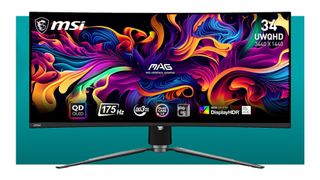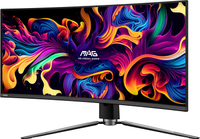MSI's latest cheaper-than-the-competition OLED gaming monitor is this sweet 34-inch ultrawide panel for $680
Is this the sweetspot for real-world OLED gaming?

MSI MAG 341CQP | 34-inch | 175 Hz | QD-OLED | $899.99 $679.99 at Amazon (save $220)
OLED gaming still isn't as affordable as we'd like. But it's getting there. This 34-inch ultrawide QD-OLED beast is the cheapest of its kind we've yet seen. The 175 Hz refresh is a tiny bit pedestrian, but it's plenty fast enough for us and in all other regards, this is the full OLED experience, including 0.03ms response and serious HDR sizzle.
Price check: $729 at Newegg
32-inch 4K or 34-inch ultrawide? If the answer is the latter, your OLED weapon of choice could well be the MSI MAG 341CQP, yours for $680 from Amazon and the cheapest we've seen this class of display.
We've just had the in-office debate over the merits of 32-inch 4K versus 34-inch 1440p ultrawide. The 4K option scores with image detail, pixel density and superior non-gaming capabilities. The 34-inch ultrawide hits back with that wrap-around sense of gaming immersion.
Then there's cost and how performance intersects with cost. The argument goes something like this. We recently spotted another MSI OLED panel, the 32-inch 4K MSI MAG 321UP on Newegg for $800. That makes it the cheapest 4K gaming OLED yet. Nice.
Now, if that was the only consideration, 4K for $800 versus 34-inch ultrawide for $680, well, you could make a strong argument for 4K. The problem is that 4K is so very demanding in terms of GPU load. So, if you're going 4K, you're going to need $900, maybe $1,000's worth of GPU to make the most of it.
With a 34-inch ultrawide and its 3,440 by 1,440 pixel grid, you're looking at just under five million pixels to the over eight million pixels of 4K. So, a $600 graphics card like an Nvidia RTX 4070 Super should suffice.
Put the GPU and OLED combo together, and the 4K option ends up at $1,700 to $1,800 and around $400 to $500 more expensive than the 34-inch ultrawide option. Of course, neither option is cheap. But the 34-inch ultrawide route is quite a bit more attainable.
If that's the broad proposition, what's good about this particular 34-inch OLED? Well, it's a Samsung-based QD-OLED panel, so that means loads of HDR pop combined with decent full-screen brightness.
Brain-bending pixel response of just 0.03ms is likewise a given. The refresh rate of 175 Hz is decent rather than spectacular. But only the most fanatical aficionados of online shooters will feel the latency gap to a 240 Hz or 360 Hz panel. For most of us, 175 Hz is plenty.
Downsides? Well, like all OLED monitors, burn-in is always a bit of a worry. Long term testing by various third party outlets tends to show only very mild burn in occurring with these modern OLEDs. Moreover, you've got three years of burn-in cover from new.
Beyond that, it's a little harder to know how these screens will fare. Will they be badly burned after five years? That's tricky to say. How long do you usually use a monitor? If you're happy buying something new after, say, four years once the warranty expires, well, that's fine. It's a subjective call in the end.
But if you do fancy a 34-inch ultrawide OLED, this MSI just made that option more affordable than ever.
The biggest gaming news, reviews and hardware deals
Keep up to date with the most important stories and the best deals, as picked by the PC Gamer team.

Jeremy has been writing about technology and PCs since the 90nm Netburst era (Google it!) and enjoys nothing more than a serious dissertation on the finer points of monitor input lag and overshoot followed by a forensic examination of advanced lithography. Or maybe he just likes machines that go “ping!” He also has a thing for tennis and cars.
Most Popular





